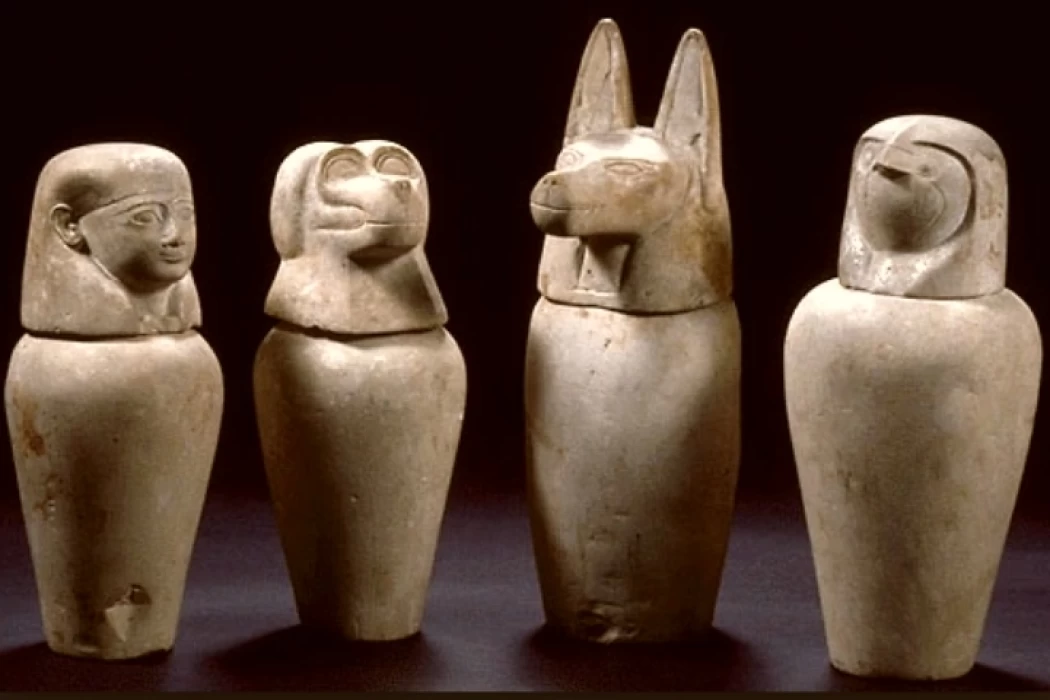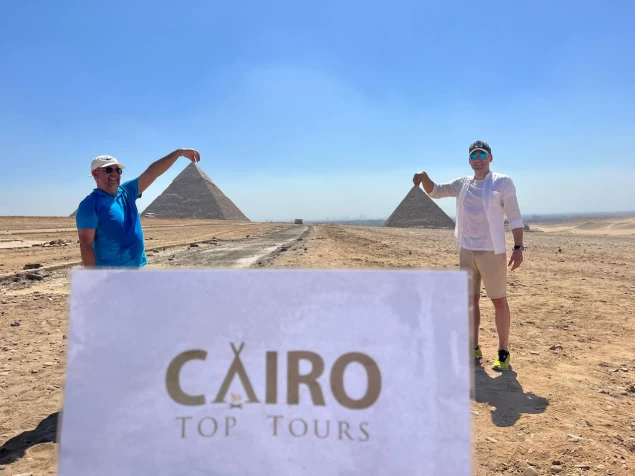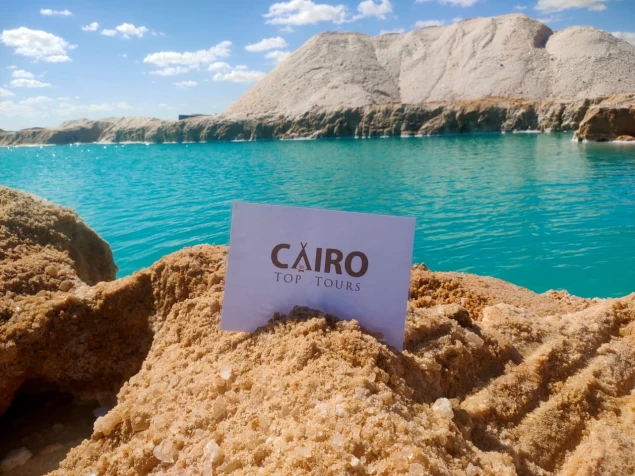
Facts About The Four Sons of Horus
"Imsety, Duamutef, Hapi, Qebehsenuef guard Osiris during his embalming and then guard the pots of the four entrails and represent the four corners of the world.
Hapi
Habi embodied the Nile flood. It was represented by the image of a man holding above his head aquatic plants.
Features of masculinity are visible in the muscles of his legs and arms; he symbolizes the fertility of the flood. The contours of femininity are shown in the chest and abdomen; they symbolize the land that has been fertilized by flood waters.
He was the master of the river, which brings growth, and the master of the fish and birds of the swamps, which symbolizes that he endowed the Egyptians with these creatures along with the Nile itself.
This symbolizes his role in uniting the northern and southern parts of the country. Habi was living in the cave from which the Nile flood comes out. And no special temple of Lord Hapi has been created.
Emsti
Emsti, with a human head, is the soul that protects the liver
Duamutvduamutef
Jackal-headed doumtov, responsible for guarding the stomach
Jackal, baboon, Falcon, and man
They are the idol "emsti", with a human head, is the soul that protects the liver;" my love", with the head of a baboon, is responsible for the lungs;" duamutv", with the head of a jackal, is responsible for guarding the stomach; and" ugbhasnov", with the head of a Falcon, is responsible for protecting the intestines.
In the novel
There have been many discussions about the origin of the four sons of Horus, and whether they were sons of Horus or sons of Uzair, and the texts have been conflicting on the issue of determining their lineage.
Matun Al-Ahram mentions in the talisman (2078a) about their lineage that their father is "horkham"" recitation: May these four Southerners stand for this net, emsti, Habi, duamut F, and ugly snow F, The Sons of HUR Al-akhmimi (horkham). Paragraph 157 of the tombstone mentions that their father was Hor the elder and their mother was ISIS.
The evolution of the bodies of the Sons of Horus
From the beginning of the appearance of the Sons of Horus in ancient Egyptian depictions until the end of the second transition era, they were mostly depicted with human heads, although a few canopic vessels from the Middle Kingdom depicted all four sons of Horus with Hawk heads.
In the case of the four sons of Horus depicted in a human form, the head of emsti was depicted as a light-skinned and bearded female, while the other heads were depicted in a dark red or black color, decorated with the divine beard, that is, they were male gods.
With the beginning of the modern state, another form prevailed, but without completely overshadowing the ancient form of human headdresses, the heads of male gods were replaced by animal ones.
In the period between the beginning of the Eighteenth Dynasty and the middle of the Nineteenth Dynasty, each of the four sons of Horus took on his distinctive animal form: he was touched by his ancient human form, Habi with the head of a monkey, duamut F with the head of a jackal, and ugly snow F with the head of a hawk.
What is noteworthy here is that although Imsi retained his ancient human form, since then he began to transform into a male idol with a dark color and a divine beard.
There are a few exceptions to this, where in one of them we find that dawamut F and UGL sanawaf replaced their heads so that the former was depicted with the head of a Falcon, while the other was depicted with the head of a jackal. This confusion has happened more than once throughout the Pharaonic ages, and the examples of this are many and varied, of which we will review some models later.
The relationship of the Sons of Horus to the four directions
The number 4 is likely to be an expression of the four sides of the universe, the sides that usually include the members of the body of the deceased God Uzair and are later assembled during the ritual revival of Uzair that takes place in the month of kehek. since the number of Horus ' sons was four, it was obvious to connect them with the four directions of the universe. But it seems that at first, they were associated only with the North and the South, and in fact, the religious texts contradict each other on this matter.
While Matun Al-Ahram refers to their southern origin, where one of her spells mentions "recitation: May these four Southerners stand for the night of this amstey, Habi, duamut F, ugh snow F-The Sons of Hor Khum".
We find the book of the dead referring in Chapter (17) of its chapters to their connection with the north, the text mentions:
"They are Amstey, Habi, duamut F, ugliness snow F, who stand behind the Big Dipper in the northern sky.
While the scenes depicted on the walls of the Tomb of King AI in the valley of the Kings show the Association of amsti and Habi only with the North and the Association of duwamut F and ugly snowaf with the south, where imsti and Habi depicted the representatives of the North wearing the red crown, while duwamut F and ugly snowf depicted the representatives of the south wearing the white crown. Perhaps the Association of emsti and Habi with the North is highlighted through their association with the spirits of him, and the Association of duamut F and ugliness snuff with the South is highlighted through their association with the spirits of nakhn, which we will talk about in a later chapter. Then soon, the Sons of Horus were associated with the four original sides and not only as representatives of the North and the South as representatives of the four pillars of heaven.
Their association with these parties was as follows: Amstey... The South is alive... North
Duamut F... East
The ugliness of snow F... The West
Mummification
The preservation of the body of the deceased was another condition of life after death, which only gradually acquired its status, bodies in prehistoric times show that there was no attempt to preserve them artificially, but cases of embalming were observed early since the first royal dynasties, and in the fourth dynasty it did not become practice. There are four pots in which the entrails of the deceased are kept, each of which was under the protection of one of the four sons of Horus, and their names are (Imsety Imsety), (Hapy Hapy), (Duamutef Duamutef), and (Ugth snuf Kebehsenuf). The fear of complete decomposition of the body led to the development of the method of embalming, and concentrated efforts were made .
It is known that the term msw hr is given to the four sons of Horus, emsti, Habi, Duamutef F and ugly snow F, who gained their fame by appearing most often on the lids of canopic pots along with their numerous other tasks in the funerary field.
In the era of the Old Kingdom
The first mention of these four gods came in the pyramids, which is considered the oldest recorded religious materials in ancient Egypt, so the spell was mentioned (2078a). "Recitation: May these four Southerners stand for this net, imsti, Habi, duamut F and ugly snow F sons of horchem" since the appearance of the four sons of Horus in the texts of the pyramids, their mention was limited to only the funerary texts and their main function was to preserve the body of the deceased in general .
In the era of the Middle Kingdom
Since the Middle Kingdom, after it became customary to cover the surfaces of the inner and outer coffins with various chapters of the funerary literature, known as the sarcophagus, mention came of these four Gods Among the group of Gods assigned to the protection of the king and these gods are: (Anbo – Geb - not - ESA - nebt - hat-the four sons of Horus) as these helped Uzair before and opened his mouth to eat and speak, they will help the deceased as well.
In the era of the new state
In the modern state, with the transformation of religious texts into the so-called Book of the dead, the mention of the Sons of Horus came more than once within the spells of this book, chapter 17 of the book of the dead mentions them as one of the Masters of justice and truth who stand behind the Great Bear in the east of heaven, and they are also mentioned in many other chapters such as (Chapter 99, 112, 137, 141) of the chapters of this book.
The four sons of Horus are four of the cosmic powers (nitro) that were associated with both Horus and Osiris and had a major role in the transition of man upon death from the material world to the other world.
The four sons of Horus appeared in the famous trial scene, and the ancient Egyptian artist portrayed them as they were standing on a lotus flower that grew from the water under the throne of Osiris in the other world.
And since the lotus flower, according to the ancient Egyptians, was associated with the creation of the universe, the four sons of Horus are also part of the system of the creation of the universe.
The Belgian engineer, Robert Boval, says that the four sons of Horus are the four stars that make up the cavity that resembles the ladle in the Big Dipper group, and that the star group occupied great importance among the ancient Egyptians.
The four sons of Horus were also associated with the human bowels.
When the mummy was mummified in ancient Egypt, the bowels of the deceased were taken out and placed in four pots called canopic pots. Each pot carries the head of one of the four sons of Horus and guards one of the human guts. It also guards the gate to one of the four original sides.
The liver, lungs, intestines, and stomach were among the organs of the deceased that were removed and wrapped separately during the mummification process in ancient Egypt. These components were subsequently put in four jars called canopic jars.
Known since the Old Kingdom and beyond, these jars have changed slightly over time. The lids of these jars were first shown in the New Kingdom as the "Four Sons of Horus," who protected the within.
From the earliest appearance of the Sons of Horus in ancient Egyptian imagery until the end of the Second Intermediate Period, they were mostly depicted with human heads.
When the Four Sons of Horus were depicted in human form, Imsety's head was depicted as a light-skinned, beardless female, while the other heads were depicted as dark red or black, adorned with the divine beard, meaning they were male deities.
With the beginning of the New Kingdom, another form became prevalent, but without completely overshadowing the ancient form of human-headed headdresses. Animal heads were used in place of the masculine deities' heads.
Between the beginning of the Eighteenth Dynasty and the middle of the Nineteenth Dynasty, each of the Four Sons of Horus took on its distinctive animal form.
There are a few exceptions to this. In one instance, Duamutef and Qebehsenuaf had their heads swapped, with the former depicted with the head of a falcon and the latter with the head of a jackal. This confusion occurred more than once throughout the Pharaonic era, and there are numerous and varied examples of this, some of which we will review below.
The number 4 likely represents the four cardinal points of the universe, which typically housed the body parts of the deceased god Osiris, and which were later reunited during the rituals of Osiris's resurrection in the month of Kiahk. Given that Horus had four sons, it was natural to associate them with the four cardinal points... However, they initially seemed to be associated only with the north and south, and in fact, religious texts conflict with each other on this matter.
While the Pyramid Texts indicate their southern origin, one of their incantations states, "Recite: May these four southerners stand for Neith this Amsety, Hapy, Duamutef, Qebeh-senuef—the sons of Horekhem."
We find the Book of the Dead referring in Chapter (17) to their association with the north. The text states: "They are Imsety, Hapy, Duamutef, and Qebehsenuef, who stand behind the Great Bear in the northern sky."
Meanwhile, the scenes depicted on the walls of King Ay's tomb in the Valley of the Kings show Imsety and Hapy's association with the north only, and Duamutef and Qebehsenuef's association with the south... Imsety and Hapy, representing the north, are depicted wearing the red crown, while Duamutef and Qebehsenuef, representing the south, are depicted wearing the white crown... The spirits of Imsety and Hapy may emphasize their link with the north, whereas the spirits of Nekhen—a subject we will address in a later chapter—highlight Duamutef and Qebehsenuef's association with the south. Soon, the Sons of Horus were associated with the four cardinal directions, not just as representatives of the north and south, but as representatives of the four pillars of heaven.
The names of the four sons of Horus are:
Dwamotif: He carries the head of a jackal and guards the stomach and stands at the northern gate
Kabeh-Sunuf: He carries a falcon's head and guards the bowels and stands at the southern gate
Hapi: He carries the head of a baboon, guards the lungs, and stands at the eastern gate
Amsit: He carries a human head and guards the liver and stands at the western gate














